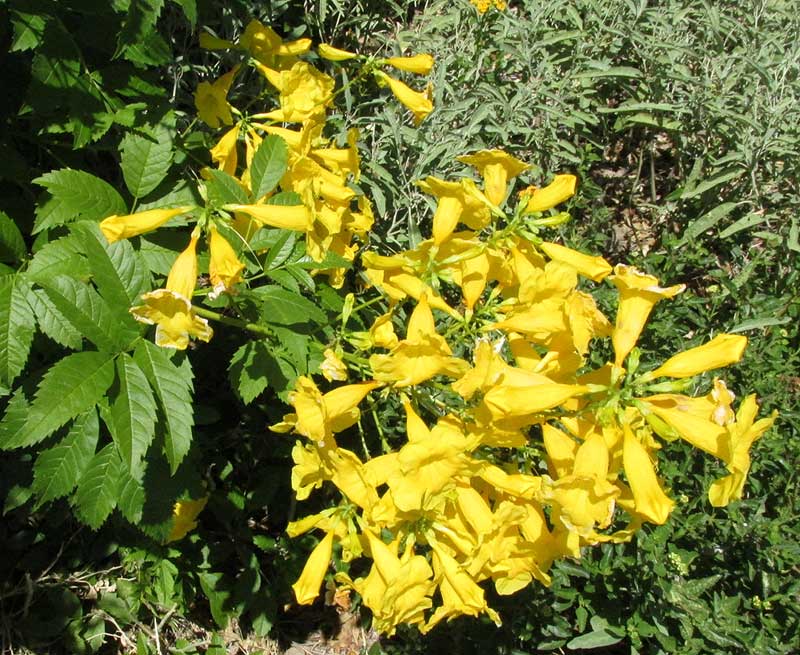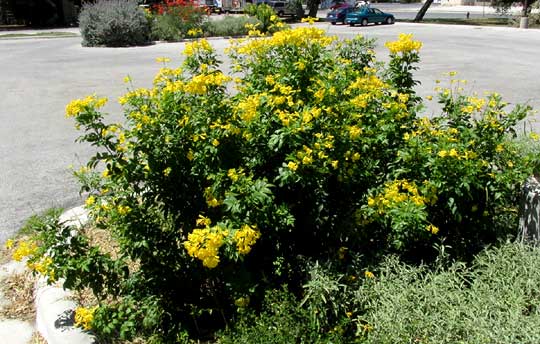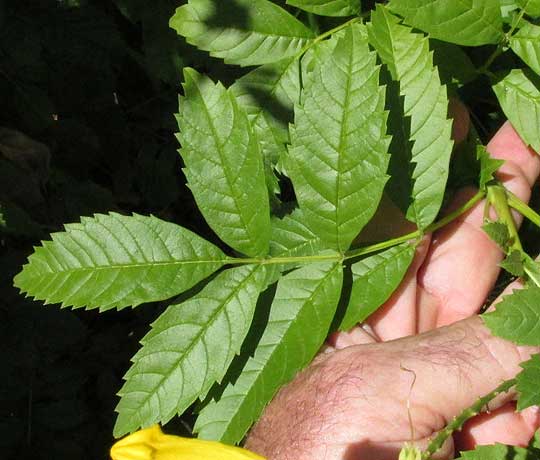Excerpts from Jim Conrad's
Naturalist Newsletter

from the September 14, 2014 Newsletter issued from the Frio Canyon Nature Education Center in the valley of the Dry Frio River in northern Uvalde County, southwestern Texas, on the southern border of the Edwards Plateau; elevation ~1750m (~5750 ft); N29.62°, W99.86°; USA
YELLOW BELLS
In the parking lot of Uvalde's fine El Progreso Memorial Library a certain much-branched, head-high bush struck me as both unfamiliar and familiar. It was unfamiliar at a distance where all that was apparent was its density and large number of fairly good sized yellow flowers, as seen below:

Up close, however, its pinnately compound leaves with conspicuously toothed leaflet margins, and its basketball-size panicles of large, trumpet-shaped, yellow blossoms, all seemed very familiar, as seen at the top of this page.
A shot of the pinnately compound leaf is shown below:

A close-up of two flowers is appears below:

In much of Mexico as well as southern and western Texas and southern Arizona and New Mexico -- in fact throughout most of tropical America as far south as Argentina -- there's a common small tree or bush looking exactly like this, except that it's a regular small tree with one or a few regular trunks, instead of consisting of very many short, slender stems arising from the bush's base.
What we have here in the library parking lot is a cultivar of the wild plant I'm remembering. Because the species is so pretty and in some places so common it goes by several English names, including Yellow Bells, Yellow Trumpetbush, Yellow Trumpet-flower and Yellow Elder. In Texas often the Spanish name is used, Esperanza.
Yellow Bells is TECOMA STANS, a member of the mostly tropical Bignonia or Trumpet Creeper Family, the Bignoniaceae. This family is especially rich in woody vines, or lianas, and usually but not always its leaves are compound and occur two to the stem node -- they're "opposite." Fruits are dry pods, often long and woody, that split on both sides to release many flattened seeds which usually bear papery "wings" helping with wind dispersal.
In the wild, Yellow Bells is partial to rocky hillsides and foothills, but also often grows in disturbed sites such as roadsides. It's also frequently cultivated for its prettiness, and in warmer areas it may escape and sometimes becomes a troublesome "weed tree."
Robert Vines in his book Trees, Shrubs & Woody Vines of the Southwest writes that Yellow Bells was long used by indigenous folks of the US Southwest and Mexico for bowmaking, bee fodder and medicines.
On the Internet many pages state that Yellow Bells is poisonous, and though bees may collect the plant's nectar and make honey, the honey is poisonous. However, these pages are mostly at garden forums and small, one-person web sites, and often the wording is the same from page to page, suggesting that the information has been copied and recopied. In fact, at the usual academic sites dealing with toxic plants, I can't find any mention of Yellow Bells' toxicity, or that honey produced from its nectar is bad.
Van Dersal in a 1942 piece writes that in Mexico the flowers yield honey, the roots a type of beer, and medicinally the plant is regarded as having diuretic, antisyphilitic, vermifuge and anti-diabetic properties -- though later studies disproved the anti-diabetic part.
I rather suspect the reports of Yellow Bells' "toxic honey," and hold with the opinion of the great L.H. Bailey, author of my precious Manual of Culivated Plants, that "The value of this shrub ... cannot be overestimated."